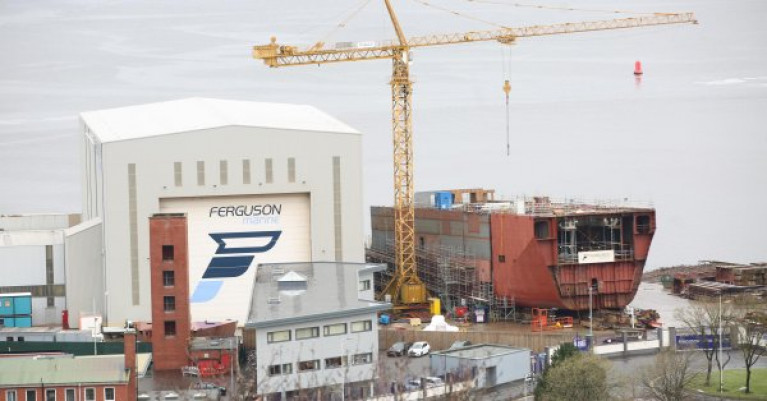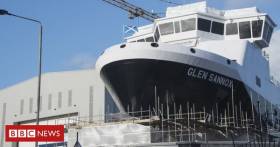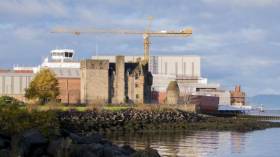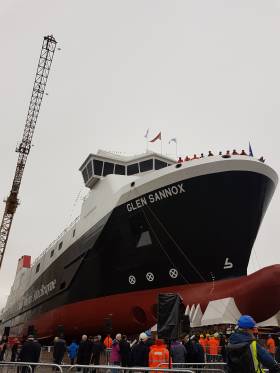Displaying items by tag: Scottish shipyard
Clyde Shipyard In Temporary Shutdown Over Covid Fears
The Scottish shipyard that was contracted to build a pair of duel-fuel ferries, Ferguson Marine is being closed down for a week with immediate effect.
Bosses say they have temporarily closed their Port Glasgow yard and Greenock warehouse with immediate effect.
The Scottish Government-owned company says this is in response to increased Covid-19 infection rates in the Inverclyde area and concerns about the new variant of the virus.
The business has contacted all employees and trade unions to advise they have suspended production for one week to allow a 'comprehensive review of measures to ensure that the working environment at the yard continues to be as safe as possible'.
Production work will resume on Monday 18th January with briefings to advise employees of any changes to Covid-19 measures and to 'reinforce the need for personal responsibility in social distancing'.
More from the HeraldScotland here.
Boss in Scotland Says Ferry Operators Will Be ‘Nervous’ About Ordering from Shipyard
In Scotland, a western based ferry boss has warned commercial operators will now be “nervous” of ordering new vessels from the Ferguson shipyard on the Clyde, amid the ongoing fallout from a contract to build two dual-fuel (ferries) to operate on the west coast.
A report by MSPs into the procurement and delivery of the two vessels for the CalMac network slammed the process as a “catastrophic failure” earlier this month. Caledonian Maritime Assets Limited (CMAL) awarded Ferguson, then owned by Jim McColl’s Clyde Blowers Capital.
The £97 million contract to build the ferries in 2015. But the process was blighted by delays, spiralling costs and a breakdown in relations between CMAL, which owns the ferries run by CalMac, and shipyard bosses.
The vessels have still to be completed and are expected to cost at least double the original contract value, with Ferguson having been nationalised last year after falling into administration.
More here reports the HeraldScotland on the ongoing shipyard saga and for a related story of recent months.
Bosses at a Scottish shipyard were “fairly and squarely” to blame for the calamitous delays and costs overruns at Ferguson Marine, it has been claimed.
As The Herald reports, Kevin Hobbs, chief executive of Caledonian Maritime Assets Ltd (CMAL) – the government body which placed the order for two new ferries at the yard – also said he was “desperately upset and desperately concerned” that they were still not ready.
An inquiry into the ferry debacle by Holyrood’s Rural Economy and Connectivity Committee will begin hearing oral evidence next week.
Ferguson Marine shipyard, which was acquired by tycoon Jim McColl’s Clyde Blowers empire in 2014, was nationalised last year after collapsing into administration in the wake of the dispute.
For more on this story click here.
Scottish Shipyard On the Clyde Taken Into Public Ownership
Shipyard Ferguson Marine has officially been taken into public ownership, the Scottish Government has announced.
The move, reports STV News, came on Tuesday after administrators agreed the final terms of the transaction with Scottish Ministers.
The yard will now be known as Ferguson Marine (Port Glasgow) Ltd.
There had been three other offers for the Inverclyde site, however administrators concluded the sale to the Scottish Government represented the best outcome for creditors.
Staff at the shipyard have been told of the latest position.
For more click here to read.
In Scotland, the last civilian shipyard on the Clyde, The Herald reports, is to be nationalised by the country's Government within a month after a search for a commercial saviour failed.
Workers at Ferguson Marine in Port Glasgow, which was driven into insolvency by a calamitous contract for two CalMac ferries, were told of the development this morning.
The government has already written off almost £50m in loans and interest to the business.
The Scottish Tories called if “potentially disastrous” for Scotland’s shipbuilding industry.
Clink link for more on this story.
Scottish Shipyard on the Clyde Has Deadline for Nationalising Postponed
Scottish National Party ministers, The Herald writes, have extended the deadline for finding a buyer for the last civilian shipyard on the Clyde.
Finance Secretary Derek Mackay told MSPs the marketing of Ferguson Marine in Port Glasgow could take 50 per cent longer than anticipated.
The business, which employs 300 workers, went into administration last month after a £97m contract for two CalMac ferries ran two years late schedule and £100m over budget.
When Mr Mackay took the yard under public control on August 16, he said ministers would nationalise it unless there was a viable commercial offer within four weeks.
However in an update at Holyrood, he marketing it would now last another two to four weeks. He said the priority for ministers was safeguarding jobs and finishing the boats.
He said: “The Scottish Government will at all times remain open to discussions with any parties interested in securing a viable commercial future for the yard. But we will also explore the option of keeping the yard in public ownership, and how this might protect sustainable shipbuilding on the lower Clyde.”
For further reading click this link
Shipyard in Scotland Rescued Could Create More Jobs to Complete Controversial Ferry Project
Additional jobs,The Scotsman writes, could be created at newly nationalised Ferguson Marine in order to complete the two vessels which nearly sank the shipyard, Scotland's economy secretary Derek Mackay has announced.
Speaking after the first meeting of the Programme Review Board, set up by the Scottish Government to run the yard, Mr Mackay suggested that workers who had been made redundant as Ferguson Marine faced administration, may be rehired.
However, he admitted that the Board had not yet looked at the firm's books, but said the aim was to ensure the ferries were completed at the "lowest possible cost to the taxpayer".
The Board was established last week to rescue the Port Glasgow shipyard as it faced administration after a huge over-run on a contract to complete two Caledonian Maritime Assets Ltd (CMAL) ferries. Ministers effectively nationalised the shipyard under an agreement with the administrators which will see them buy the facility if no private bid emerges within the next month.
The yard, which employs 300 staff, had faced closure five years ago, but was saved by SNP economic adviser and billionaire businessman Jim McColl, and then won the £97m public contract to build the two ferries for Caledonian MacBrayne. However as costs mounted, the Scottish Government loaned £45m to Ferguson Marine in an attempt to get the ferries completed - money it may now have to write off.
For further reading click here on the much delayed duel-fuel ferries destined to serve the Isle of Arran and on the Uig Triangle services.
Ferguson Marine to Lodge Claim in Arran, Scotland Ferry Design Row
#ferry- In a row between a Scottish shipyard and operator over claims that "significant design changes" to CalMac's delayed new Arran ferry today (Friday, 7 Dec.) has escalated to legal action, reports The Scotsman.
Port Glasgow shipbuilders Ferguson Marine Engineering Limited (Fmel) announced it planned to make a claim against Scottish Government-owned Caledonian Maritime Assets Limited (Cmal) - which owns CalMac's ferries - over the £97 million contract for the as previously Afloat.ie covered Glen Sannox and a sister vessel.
It said a claim would be lodged "within weeks" over the project to build the ferries which will be able to run on liquid natural gas or diesel.
Fmel has blamed the changes and the newness of the technology involved for delays to the Glen Sannox, which could now enter service on the main Arran route (see piece) a year late.
It may not now carry passengers until next autumn.
For further comments from both Fmel and Cmal, click here.































































